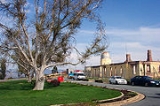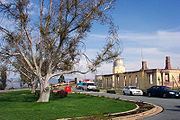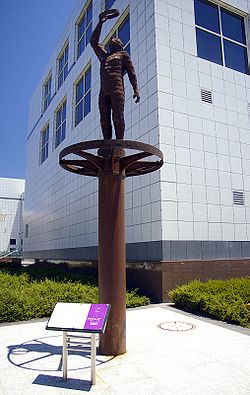
Mount Stromlo Observatory
Encyclopedia



Canberra
Canberra is the capital city of Australia. With a population of over 345,000, it is Australia's largest inland city and the eighth-largest city overall. The city is located at the northern end of the Australian Capital Territory , south-west of Sydney, and north-east of Melbourne...
, Australia
Australia
Australia , officially the Commonwealth of Australia, is a country in the Southern Hemisphere comprising the mainland of the Australian continent, the island of Tasmania, and numerous smaller islands in the Indian and Pacific Oceans. It is the world's sixth-largest country by total area...
, is part of the Research School of Astronomy
Astronomy
Astronomy is a natural science that deals with the study of celestial objects and phenomena that originate outside the atmosphere of Earth...
and Astrophysics
Astrophysics
Astrophysics is the branch of astronomy that deals with the physics of the universe, including the physical properties of celestial objects, as well as their interactions and behavior...
at the Australian National University
Australian National University
The Australian National University is a teaching and research university located in the Australian capital, Canberra.As of 2009, the ANU employs 3,945 administrative staff who teach approximately 10,000 undergraduates, and 7,500 postgraduate students...
(ANU).
History
The observatoryObservatory
An observatory is a location used for observing terrestrial or celestial events. Astronomy, climatology/meteorology, geology, oceanography and volcanology are examples of disciplines for which observatories have been constructed...
was established in 1924
1924 in Australia
See also:1923 in Australia,other events of 1924,1925 in Australia and theTimeline of Australian history.-Incumbents:*Monarch – King George V*Governor-General – Henry Forster, 1st Baron Forster*Prime Minister – Stanley Bruce-State premiers:...
as The Commonwealth Solar Observatory
Solar telescope
A solar telescope is a special purpose telescope used to observe the Sun. Solar telescopes usually detect light with wavelengths in, or not far outside, the visible spectrum.-Professional solar telescopes:...
. The Mount Stromlo
Mount Stromlo
Mount Stromlo is situated a short drive west of the centre of Canberra, Australia, near the district of Weston Creek. Its peak is at approximately 770m AHD....
site had already been used for observations in the previous decade, a small observatory being established there by Pietro Baracchi
Pietro Baracchi
Pietro Paolo Giovanni Ernesto Baracchi was an Italian-born astronomer, active in Australia and Government Astronomer of Victoria 1900-15....
using the Oddie telescope being located there in 1911. The dome built to house the Oddie telescope was the first Commonwealth building constructed in the newly established Australian Capital Territory
Australian Capital Territory
The Australian Capital Territory, often abbreviated ACT, is the capital territory of the Commonwealth of Australia and is the smallest self-governing internal territory...
. Until World War II
World War II
World War II, or the Second World War , was a global conflict lasting from 1939 to 1945, involving most of the world's nations—including all of the great powers—eventually forming two opposing military alliances: the Allies and the Axis...
, the observatory specialised in solar and atmospheric observations. During the war the workshops contributed to the war effort by producing gun sights, and other optical equipment. After the war, the observatory shifted direction to stellar and galactic astronomy and was renamed The Commonwealth Observatory.
The ANU was established in 1946 in nearby Canberra and joint staff appointments and graduate studies were almost immediately undertaken. A formal amalgamation took place in 1957 with Mount Stromlo Observatory becoming part of the ANU.
On January 18, 2003 the devastating Canberra firestorm hit Mount Stromlo (which was surrounded by a plantation pine forest) destroying five telescopes, workshops, seven homes and the heritage listed administration building. The only telescope to escape the fires was the 1868 15-centimetre Farnham telescope. Relics from the fire are preserved in the collection of the National Museum of Australia
National Museum of Australia
The National Museum of Australia was formally established by the National Museum of Australia Act 1980. The National Museum preserves and interprets Australia's social history, exploring the key issues, people and events that have shaped the nation....
. They include a melted telescope mirror and a piece of melted optical glass (flint). The latter has pieces of charcoal and wire fused into it from the fierce heat of the fire.
Redevelopment is largely completed and the Observatory is now a major partner in the construction of the Giant Magellan Telescope
Giant Magellan Telescope
The Giant Magellan Telescope is a ground-based extremely large telescope planned for completion in 2018. It will consist of seven diameter primary segments, with the resolving power of a primary mirror and collecting area equivalent to one...
. The current observatory director is Harvey Raymond Butcher
Harvey Raymond Butcher
Harvey Raymond Butcher III is an astronomer who has made significant contributions in observational astronomy and instrumentation which have advanced understanding of the formation of stars and of the universe. He received a B.Sc...
.
Research
The MACHOMacho
Macho typically refers to machismo. Other uses include:*Macho , a short-lived disco group in the late 1970s*Pique macho, Bolivian dish*Macho Man , a 1978 disco song performed by the Village People...
project detected the first instance of the gravitational lensing of one star by another, known as Gravitational microlensing
Gravitational microlensing
Gravitational microlensing is an astronomical phenomenon due to the gravitational lens effect. It can be used to detect objects ranging from the mass of a planet to the mass of a star, regardless of the light they emit. Typically, astronomers can only detect bright objects that emit lots of light ...
, in 1993 (Alcock et al. 1993; Paczynski 1996). This discovery was made by repeated imaging of the Magellanic Clouds with the refurbished 50-inch Great Melbourne Telescope which was equipped with a mosaic of 8 2048 by 2048 pixel CCD
Charge-coupled device
A charge-coupled device is a device for the movement of electrical charge, usually from within the device to an area where the charge can be manipulated, for example conversion into a digital value. This is achieved by "shifting" the signals between stages within the device one at a time...
s. The camera was constructed by the Centre for Particle Astrophysics in California (CFPA), and at the time was the largest digital camera ever built (Frame & Faulkner 2003). Observations began in July 1992 and the project concluded in December 1999. In total, the MACHO project made over 200 billion stellar measurements, with the
data processed both at the observatory and at the Lawrence Livermore National Laboratory
Lawrence Livermore National Laboratory
The Lawrence Livermore National Laboratory , just outside Livermore, California, is a Federally Funded Research and Development Center founded by the University of California in 1952...
.
Brian Schmidt
Brian P. Schmidt
Brian P. Schmidt is a Distinguished Professor, Australian Research Council Laureate Fellow and astrophysicist at the Australian National University Mount Stromlo Observatory and Research School of Astronomy and Astrophysics and is widely known for his research in using supernovae as Cosmological...
organised an international collaboration, known as the High-z Supernova Search Team
High-z Supernova Search Team
The High-z Supernova Search Team was an international cosmology collaboration which used Type Ia Supernovae to chart the expansion of the Universe. The team was formed in 1994 by Brian P. Schmidt, then a post-doctoral research associate at Harvard University, and Nicholas B. Suntzeff, a staff...
, to study the rate of change of the Cosmic Expansion using type Ia supernova
Supernova
A supernova is a stellar explosion that is more energetic than a nova. It is pronounced with the plural supernovae or supernovas. Supernovae are extremely luminous and cause a burst of radiation that often briefly outshines an entire galaxy, before fading from view over several weeks or months...
e. In 1998, the team reach the conclusion that the cosmic expansion was accelerating
Accelerating universe
The accelerating universe is the observation that the universe appears to be expanding at an increasing rate, which in formal terms means that the cosmic scale factor a has a positive second derivative, implying that the velocity at which a given galaxy is receding from us should be continually...
, contrary to expectations. This universal acceleration implies the existence of dark energy
Dark energy
In physical cosmology, astronomy and celestial mechanics, dark energy is a hypothetical form of energy that permeates all of space and tends to accelerate the expansion of the universe. Dark energy is the most accepted theory to explain recent observations that the universe appears to be expanding...
and was named the top science breakthrough of 1998 by Science magazine. In 2011, Brian P. Schmidt
Brian P. Schmidt
Brian P. Schmidt is a Distinguished Professor, Australian Research Council Laureate Fellow and astrophysicist at the Australian National University Mount Stromlo Observatory and Research School of Astronomy and Astrophysics and is widely known for his research in using supernovae as Cosmological...
shared the Nobel Prize in Physics
Nobel Prize in Physics
The Nobel Prize in Physics is awarded once a year by the Royal Swedish Academy of Sciences. It is one of the five Nobel Prizes established by the will of Alfred Nobel in 1895 and awarded since 1901; the others are the Nobel Prize in Chemistry, Nobel Prize in Literature, Nobel Peace Prize, and...
with Saul Perlmutter
Saul Perlmutter
Saul Perlmutter is an American astrophysicist at the Lawrence Berkeley National Laboratory and a professor of physics at the University of California, Berkeley. He is a member of the American Academy of Arts & Sciences, and was elected a Fellow of the American Association for the Advancement of...
and Adam Riess
Adam Riess
Adam Guy Riess is an American astrophysicist at Johns Hopkins University and the Space Telescope Science Institute and is widely known for his research in using supernovae as Cosmological Probes. Riess shared both the 2006 Shaw Prize in Astronomy and the 2011 Nobel Prize in Physics with Saul...
for such observations which provided evidence for the accelerating Universe.
The 2dF Galaxy Redshift Survey
2dF Galaxy Redshift Survey
In astronomy, the 2dF Galaxy Redshift Survey , 2dF or 2dFGRS is a redshift survey conducted by the Anglo-Australian Observatory with the 3.9m Anglo-Australian Telescope between 1997 and 11 April 2002. The data from this survey were made public on 30 June 2003...
, co-led by Matthew Colless, undertook the largest galaxy redshift survey of its time, and was conducted at the Anglo-Australian Observatory
Anglo-Australian Observatory
The Australian Astronomical Observatory , formerly the Anglo-Australian Observatory, is an optical/near-infrared astronomy observatory with its headquarters in suburban Sydney, Australia...
(AAO) with the 3.9m Anglo-Australian Telescope
Anglo-Australian Telescope
The Anglo-Australian Telescope is a 3.9 m equatorially mounted telescope operated by the Australian Astronomical Observatory and situated at the Siding Spring Observatory, Australia at an altitude of a little over 1100 m...
between 1997 and 11 April 2002. In total, the survey measured more than 245,000 galaxies, providing, along with the Sloan Digital Sky Survey
Sloan Digital Sky Survey
The Sloan Digital Sky Survey or SDSS is a major multi-filter imaging and spectroscopic redshift survey using a dedicated 2.5-m wide-angle optical telescope at Apache Point Observatory in New Mexico, United States. The project was named after the Alfred P...
, the definitive measurements of large scale structure in the low-redshift Universe.
Advanced instrumentation
The instrumentation group at Mount Stromlo Observatory has built two instruments for the Gemini Telescope. This includes the near infrared integral field spectrometer, NIFS, deployed on Gemini-North, and the adaptive optics imager for Gemini-South, GSAOI. NIFS, when nearly completed, was destroyed in the bushfires of 18 January 2003, and rebuilt.A new rapid survey telescope, SkyMapper
SkyMapper
SkyMapper is a fully automated 1.35m wide-angle optical telescope at Siding Spring Observatory in northern New South Wales, Australia. It is one of the telescopes of the Research School of Astronomy and Astrophysics of the Australian National University...
, is under construction. SkyMapper will reside at the ANU's other observatory (Siding Spring
Siding Spring Observatory
Siding Spring Observatory near Coonabarabran, New South Wales, Australia, part of the Research School of Astronomy & Astrophysics at the Australian National University , incorporates the Anglo-Australian Telescope along with a collection of other telescopes owned by the Australian National...
) and operated remotely from Mount Stromlo.
Location

Mount Stromlo
Mount Stromlo is situated a short drive west of the centre of Canberra, Australia, near the district of Weston Creek. Its peak is at approximately 770m AHD....
. Situated west of the centre of Canberra, near the district of Weston Creek
Weston Creek
Weston Creek is a residential district of Canberra, Australian Capital Territory, Australia, situated to the west of the Woden Valley district and approximately 13 km southwest of the Canberra city centre...
. Canberra's main water supply treatment plant is located nearby.
External links
- ANU Website
- Research School of Astronomy and Astrophysics at the ANU
- SkyMapper Website.
- Mt. Stromlo. SLR Global Performance Report Card
- Most important of all has been the scientific output of the Observatory

